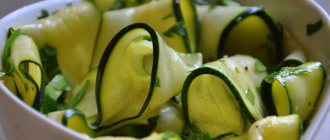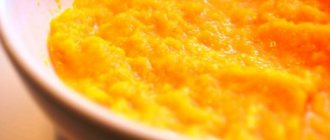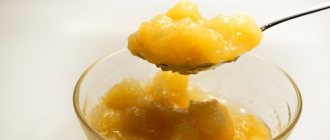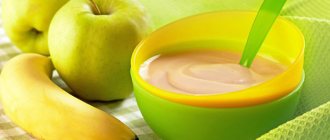At 4–6 months, the baby’s diet, in addition to mother’s milk or formula, is supplemented with a new product. Pediatricians prescribe the first complementary foods in the form of cereals (porridges) if there is poor weight gain in the baby, a tendency to irregular bowel movements or allergic manifestations. Vegetables are recommended as complementary foods for infants with anemia, rickets, and a tendency to constipation. An excellent option for vegetable introduction is a one-component cauliflower puree for babies. It is only important for mom to understand how to prepare homogenized cauliflower puree and how to make it as healthy as possible for the baby.
Beneficial features
All successful parents have heard about the benefits of vegetables for their baby. The preservation of these properties depends on the storage conditions of the inflorescences, the method of cooking, etc. Many pediatricians recommend white and green types of vegetables due to their hypoallergenicity and taste neutrality. Therefore, just like cauliflower, your child can also be given fresh broccoli.
The benefits of these light inflorescences are due to the presence in its composition of a number of vitamins, minerals and fiber. In addition, cauliflower for children is an excellent supplier of protein, which is so necessary for full growth and development. Due to its unique composition, the vegetable has the following beneficial effects on the baby’s body:
- participates in maintaining the required level of beneficial microbacteria in the intestinal bacterial environment;
- strengthens the walls of blood vessels and the muscles of the heart;
- potassium helps regulate fluid balance in the body and is involved in the process of muscle contractions;
- vitamin B regulates the process of transforming food into energy;
- participates in the regulation of nervous activity processes;
- helps with iron deficiency conditions;
- the fibrous structure of the vegetable improves the functioning of the gastrointestinal tract;
- has anti-inflammatory, antioxidant and antitumor properties.
When preparing broccoli and cauliflower for your baby, it is worth remembering that the benefits of the inflorescences are reduced when exposed to microwaves (microwave oven) during cooking. The properties of vegetables are preserved if freezing rules are observed. At the same time, frozen vegetable inflorescences must be properly defrosted, stored and, accordingly, cooked.
Nutritional value of cauliflower
So, what exactly is healthy about cauliflower?
100 grams of vegetables contain 2.5 grams of protein, 0.3 grams of fat, 4.2 grams of carbohydrates.
There is 90 grams of water here.
What vitamins are in cauliflower?
These are B vitamins - B1, B2, B4, B5, B6, B9, B12.
And:
C – participates in metabolism, increases the digestibility of collagen protein, is useful for the growth of bones and muscles, is responsible for capillary permeability,
D – the main role is to increase the absorption of calcium and phosphorus, and is also responsible for blood clotting, the functioning of the nervous system and an adequate immune response,
E - fights free radicals and strengthens the immune system,
and so on.
Of the micro- and macroelements, there is potassium (210 mg), calcium (26 mg), magnesium (17 mg), sodium (10 mg), iron (1.4 mg), copper (42 mcg), as well as silicon, sulfur , phosphorus, manganese, cobalt, selenium, fluorine, etc.
The composition of cauliflower also contains starch and dextrins - 0.4 g.
Weakens or strengthens
This question often worries mothers whose children experience constipation. The gastrointestinal tract processes in infants and infants are still not fully formed, which is why the problem of constipation is familiar to many 1-year-old babies.
Pediatrician recommendations regarding the introduction of cauliflower puree for the first complementary foods are often associated specifically with the problems of constipation in children. The inflorescences have a mild laxative effect on infants due to their fiber content. Broccoli puree for babies also weakens.
Constipation can be caused not so much by foods as by the fact of complementary feeding itself. After all, food that is new in composition and consistency can cause a kind of “stress” for the baby’s gastrointestinal tract, which can result in diarrhea, constipation or increased gas formation. It is necessary to inform your pediatrician about stool abnormalities and then follow the recommendations for the introduction of products. In addition, the baby may become weak due to a lack of fluid in the body, so it is equally important to maintain a drinking regime.
When to use cabbage as complementary food
The best nutrition for a baby is mother's milk. Therefore, the question often arises: from how many months can a baby eat cauliflower and how to introduce cauliflower into complementary foods? When breastfeeding, complementary feeding can be started from 5.5 to 6.5 months.
Mother's milk still copes with all the needs of the child's body, so there is no need to worry that the child will not receive enough nutrients. Don't rush into starting complementary feeding.
- For the first feeding, vegetables that grow traditionally in your area and are not brightly colored are suitable;
- You can start with purees of the required consistency or give your child a microdose of boiled cauliflower;
- A microdose is a small piece, the size of a grain of rice;
- The child will try a new taste, try to swallow;
- The food will enter the stomach and trigger the production of the necessary enzymes for digestion;
- If you give your child food in a piece, you will see that it will come out undigested. However, the same thing happens with purees, just because of the liquid consistency, you won’t be able to see it in the baby’s stool.
Read more about this in the article Stool after the introduction of complementary foods>>>.
What does this tell us? The gastrointestinal tract is only training and the child is not ready to take large amounts of food.
- During the season, it is advisable to make puree from fresh cauliflower. You can easily get by with your own preparation:
- First you need to puree one vegetable;
- After, by seven months, prepare a combined puree of vegetables that you will be completely confident in.
- If the introduction period falls in the winter: canned food or preparation from frozen vegetables is used. I’ll tell you below how to freeze cabbage to feed your baby.
Jars are convenient for travel or when force majeure occurs in the house. In this case, canned food is very helpful.
By the way! I would not recommend constantly feeding your child canned foods, because nothing compares to freshly prepared purees from properly selected products.
If you have chosen to puree the cabbage for now, then grind it to the required consistency using a blender.
Allergenicity degree
It is often recommended to start complementary feeding with cauliflower due to the low degree of allergenicity of the inflorescences and relative safety for the child. However, allergic reactions still occur. Flushing of the skin, urticaria, itching or upset stool are signs of negative manifestations.
As a rule, allergic reactions are caused by substances that are used in growing vegetables (nitrates, pesticides, etc.). Products used to increase shelf life or accelerate ripening can also cause allergies.
In certain cases, allergies can be caused by a protein contained in large quantities in succulent inflorescences or by the chitinase enzyme.
Are there any contraindications?
In addition to the possibility of an allergy to cauliflower and increased bloating in a child, you should not include juicy inflorescences in the diet without consulting a pediatrician.
- The vegetable can increase stomach acidity. You should not use it if there are disturbances in the gastrointestinal tract.
- May cause disturbances in the functioning of the thyroid gland.
- Affects kidney function.
General principles of introduction
The prepared product is introduced into the baby’s diet, observing certain principles that will help avoid an adverse reaction in the baby’s body:
- At what age the pediatrician decides to start complementary feeding. Complementary foods are not introduced earlier than 4 months of age - the child’s digestive enzymes are not yet able to cope with “adult” foods, immature neuromuscular coordination, the reflex of pushing out food, lack of teeth. WHO believes that the most acceptable age for this is 6 months. At 4 months, it is recommended to give complementary foods to children prone to rickets and anemia. When to introduce vegetables depends on many individual characteristics of the baby’s development.
- New products are offered only to healthy babies.
- You should not give complementary foods to your baby after vaccinations, during illness, or in the presence of stressful circumstances (moving, etc.).
- They begin to give “adult” food with about.5 teaspoon, gradually increasing the amount to the required portion.
- It is recommended to introduce new products in the morning, monitoring the baby’s condition throughout the day.
- Up to 6–7 months, products are offered in homogenized form.
- Give a new product immediately before feeding with breast milk (formula) if there are signs of food excitement (hunger);
- For the first time, only single-component products are introduced.
How to feed properly
The head of cauliflower should not fall apart - it should be strong, heavy and the same color (white or slightly creamy) without inclusions or dark spots. It is not recommended to choose frozen cabbage for children, since when frozen, cabbage loses most of its vitamins and other substances.
remove leaves;
It is better to start complementary feeding at six months, because earlier the baby’s body does not need additional nutrients. You need to introduce the vegetable in small doses. For example, for the first feeding it is better to give a teaspoon of the dish and monitor the baby’s reaction to the product. If there are no allergic rashes or problems with stool, then within a day the baby can be offered two spoons.
During the first week, you need to increase the daily portion of puree to forty grams, and then feed the child according to the daily intake of vegetables. So, at six months the norm for a child is one hundred grams, at seven - one hundred and fifty, at eight - one hundred and eighty, from nine to twelve - two hundred grams. How many grams of product are obtained in the finished dish is determined using electronic scales.
For the first two weeks, complementary feeding should be without one component, but at the next stage, two milliliters of vegetable oil are added to each vegetable meal. You shouldn’t completely leave your baby without breastfeeding - most babies like to “eat” their mother’s milk after complementary feeding. This will make the transition to vegetable food less traumatic and comfortable.
Rules for selection and storage
Before preparing cauliflower puree for babies and choosing a recipe, it is important to familiarize yourself with some of the features and rules for choosing good fresh inflorescences.
- You should not choose soft vegetables; it is better to give preference to small, solid, dense inflorescences with leaves.
- The white or soft cream color of a vegetable is a sign of its freshness. Products with blackening or a yellow frame around the edge of the inflorescence should be discarded.
- Leaves are a kind of indicator of fruit freshness. Green and crispy - they indicate the high quality of the selected vegetable.
Of course, special attention should be paid to the reputation of the seller. We buy products for the baby only from certified, experienced retail outlets.
Fresh cauliflower inflorescences should not be stored in the refrigerator for a long time: the fruits can be stored for no more than 10 days, provided they are of good quality.
When frozen, many of the beneficial properties of cauliflower are preserved.
How to store
https://www.youtube.com/watch?v=
Vegetables can be stored in two ways - in the refrigerator in a special compartment for vegetables, or frozen in the freezer. Cabbage does not last long in the refrigerator, but it can be prepared at any time. But for long-term storage it is better to use the freezer. The inflorescences are separated, soaked in salt, washed, dried on a paper towel and placed in portions in plastic bags. Next, the vegetable needs to be frozen. The product is stored in this form for a long time, and small portions are convenient to defrost and cook a fresh dish.
Tags: cook, cabbage, necessary, child, how much, cauliflower
About the author: admin4ik
« Previous entry
Industrial canned food - professional opinion
WHO recommends giving preference to industrially produced canned food for feeding children in the first year of life. These recommendations are justified by observing in production the necessary conditions for the manufacture of a quality product using proven raw materials. In addition, the balance of nutrients, vitamins and minerals in such products is subject to strict control.
Pediatricians advise using canned products only in the first months of introducing complementary foods, then replacing them with home-cooked dishes.
It is important to remember that industrial children's products should not contain starch, salt, spices, or other foreign components. Carefully study the information regarding expiration dates.
Cooking features
Having understood the rules for choosing a curly vegetable and how cauliflower is useful, you can start cooking. In order to preserve all the properties of the inflorescences, a young mother needs to know how to prepare cauliflower for the first feeding in the most beneficial way.
Recipe for cauliflower puree for babies
- The inflorescences, cleared of leaves, must be thoroughly washed, cut into pieces, coarse fibers removed (from old vegetables), and soaked in water with a little salt added for half an hour. Frozen vegetables should not be thawed or washed.
- Place the cabbage in boiling water and close the container. Cook for 10–12 minutes after boiling. How long to cook cauliflower for complementary feeding depends on the size of the inflorescences and their freshness. Young small inflorescences cook faster.
- Grind the boiled vegetables to a homogeneous mass using a small amount of vegetable broth, cool.
How to freeze to preserve maximum usefulness
When freezing, you need to follow very simple rules and your baby will be provided with full-fledged healthy cauliflower for the winter.
- you need to choose a dense head of cabbage, without spots;
- separate the leaves and divide into inflorescences (so easy to store);
- soak in salt water and soak for about ten minutes;
- Rinse;
- keep in boiling water for three minutes;
- dry (wet vegetables cannot be frozen);
- portion into one preparation;
- This cabbage can be stored for about nine months.
Popular questions
The introduction of complementary foods is an important stage in a baby’s life and often raises many questions among young mothers.
- How to cook cauliflower for complementary feeding in a slow cooker? Place the peeled and washed inflorescences in the multicooker bowl. Cook in the “Steam” mode for about 10–15 minutes. Chop the vegetables further and cool.
- How long to cook cauliflower for a child in a double boiler? Steam the inflorescences for 25 - 30 minutes. Frozen vegetables can take about 35 minutes to cook.
- Is it possible to cook vegetables with spices? From 9 months it is allowed to add bay leaves, white pepper and spicy vegetables (dill, celery) to children's dishes.
- Can oil be used in the nutrition of children of the first year of life? You can add cold-pressed vegetable oil (olive, flaxseed, cedar, etc.) to the finished vegetable dish, no more than 6 g (the volume for a one-year-old child).
- When can you give cabbage soup? Vegetable soup can be prepared in the form of pureed soups for a 7-month-old baby. Gradually, children's soups become more varied with new vegetables: zucchini, carrots, pumpkin, potatoes. Use broth soup recipes for children over 2 years old. Vegetable soup is given to children in an amount of no more than 50 ml; it stimulates the secretion of gastric juice, enzymes and increases appetite.
- What if your child doesn't eat cauliflower? You should not force your baby to eat. If a child does not like this or that type of product, this does not mean that he will not love it in the future. It might be worth taking a break and starting offering it again. In addition, to instill a love for vegetables, parents should consume them themselves.
- How to freeze cauliflower? To freeze the inflorescences for a child, you must first wash them, peel them, and separate them into portions. In some cases, it is recommended to freeze boiled and quickly cooled cauliflower. To feed your child, it is better to make several small one-time servings by placing vegetables in containers or vacuum bags for freezing. The benefits of inflorescences are preserved even in frozen form, it is only important not to store them for too long - no more than 6-8 months.
To successfully start complementary feeding, it is important for mom to know how to properly prepare and introduce foods into the baby’s diet. Compliance with the proposed recommendations will be the key to a successful and safe step towards introducing the baby to the parents’ table.
Types of complementary feeding: pediatric and pedagogical
Pedagogical
This is a new approach to getting to know adult food, developing interest in new tastes and eating independently.
In pediatric cases, everything is calculated according to plan: time, volume, type. When teaching, there are no strict rules - you feel your baby.
- The main difference is that food is not prepared separately. Your diet mainly consists of foods that are allowed for your baby. For example: soup without sauteing and frying, without fatty meats, etc.;
- The child, together with his parents, tries “adult” food in micro doses. You cannot force your baby to eat. He is just getting acquainted, the main food is mother's milk;
- With pedagogical complementary feeding, with age there is no need to grind food. When your baby can chew, he becomes familiar with solid foods and learns to swallow;
- At five months of age, the tongue pushing (spitting) reflex disappears. The baby can already sit up, chew and digest food;
- At first he sits in his mother's arms. After trying one product, you need to take a break for a couple of days to see a negative reaction if it appears;
- Over time, the number of microdoses increases. The baby can already sit independently in his own place (chair) and use his own plate.











